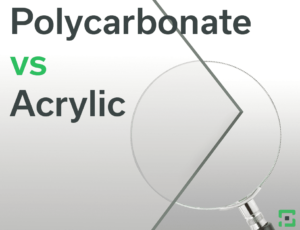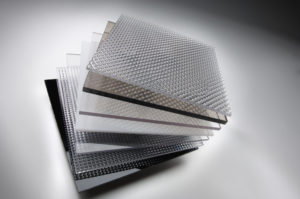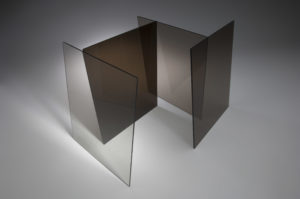 What do you need to know about comparing polycarbonate sheets vs. acrylic sheets? Acrylic and polycarbonate are two of the most popular materials for plastic fabrication companies. Both materials offer plenty of benefits and work in a wide array of applications, from vehicle operator protection to retail display cases.
What do you need to know about comparing polycarbonate sheets vs. acrylic sheets? Acrylic and polycarbonate are two of the most popular materials for plastic fabrication companies. Both materials offer plenty of benefits and work in a wide array of applications, from vehicle operator protection to retail display cases.
More specifically, both materials provide clear visibility and offer a stronger barrier than traditional glass. They’re also lightweight and tend to hold up very well throughout the years. So they can be a very economical and practical solution in a wide array of applications.
However, there are some key differences between these two types of sheeting. So it helps to have a grasp on the qualities and the pros and cons of each option so you can choose the one that is best suited to your specific project. This can help you maximize your investment and create products or solutions that are able to do their job properly and hold up as intended over time.
Acrylic and polycarbonate are known by various trade names. One of the most popular brands of polycarbonate offered by Polymershapes is LEXAN™ from SABIC, other brands of polycarbonate are known as Palsun from Palram, or Tuffak (formerly Makrolon) from Plaskolite. Acrylic is also offered under a variety of brand names, including OPTIX from Plaskolite, Plexiglas from Trinseo, or Acrylite from Roehm.
If you’re looking for plastic sheeting for an upcoming project and you’re trying to decide between polycarbonate sheets and acrylic sheets, here’s a guide that can help you determine the best option for your business.
How Do Polycarbonate Sheets and Acrylic Sheets Differ in Material Composition?
When it comes to polycarbonate sheets vs. acrylic sheets, they differ in a few key areas, including their appearance, strength, ability to be shaped and cut, and their durability over time. When it comes to their appearance, both are generally clear and look very similar to one another from afar. While both materials are transparent, acrylic tends to be glossy and it stays “water”clear over time, whereas polycarbonate can have a slight blue or grey tint and can also yellow over time with exposure to UV rays, unless using a specific UV grade.
In terms of strength, polycarbonate comes out on top. Acrylic is known for being about 10 times more impact resistant than glass, while polycarbonate is about 250 times more impact resistant than glass. They’re both fairly durable. But acrylic is a bit more rigid than polycarbonate at room temperature, so it is more likely to chip or crack when struck with a sharp or heavy object. However, acrylic has a higher pencil hardness than polycarbonate, and is more resistant to scratches. Polycarbonate, is not able to be polished in order to restore clarity, whereas acrylic can be polished if there’s a very small imperfection present. Both materials are also commonly offered with additional scratch resistant coated grades, if the application requires superior scratch and mar resistance.
The way these two materials are shaped and formed is also different. Polycarbonate tends to be fairly flexible at room temperature, which is one of the qualities that makes it so impact resistant. So it can be shaped without applying extra heat (a process commonly referred to as cold forming). It is known for being fairly easy to machine and cut. Acrylic is more rigid, so it does need to be heated in order to form it into various shapes. However, heat does not damage or break down the material at all, so it is a great option for thermoforming. Once it’s cooled, you can still enjoy full visibility and improved strength over traditional glass. Both materials are able to be cut cold, and do not require a heating process.
How Do Polycarbonate Sheets and Acrylic Sheets Differ in Application Usage?
Now that you know the basic differences between the two materials, how do these qualities impact how each of these materials are used? Basically, acrylic is usually preferred in instances where a very clear and lightweight material is needed. It can also be the optimal choice in instances where a very specific size and shape is required, since it’s easy to form without impacting the visibility. Acrylic can also be formed without a pre-drying process, which is required in polycarbonate forming. However, polycarbonate is often preferred in instances where extreme strength is needed, or in instances where the material may be exposed to high heat (or flame resistance), since acrylic can become too flexible in that environment.
More specifically, polycarbonate sheeting is popular in the following instances:
- Bullet resistant “glass” windows and doors
- Windshields and operator protection in various vehicles
- Clear visors in protective sporting gear
- Technology cases
- Machinery guards
- Protective guards in industrial settings where heat or chemicals are present
- UV grades for signage and outdoor use
And acrylic sheeting is popular in these applications:
- Retail display cases
- Light fixtures and diffusing panels
- Transparent shelves and holders for brochures or print materials
- Indoor and outdoor signage
- Craft of DIY projects
- Skylights or exterior windows that are exposed to excessive UV rays
Both polycarbonate sheets vs. acrylic sheets offer a ton of benefits over glass and other transparent materials. So finding a reliable plastics distributor that can provide both types of sheets to you in order to meet all of these different needs.
If you’re looking for a plastics distributor that offers both polycarbonate and acrylic sheets, Polymershapes should be your first choice. In addition to offering quality materials from industry leading manufacturers, we also offer a variety of fabrication and customization options to ensure that your polycarbonate and acrylic sheets meets your exact needs in terms of size, visibility, strength, and durability. We’re a nationwide brand with local facilities to deliver fast order processing and personalized service.
In addition to acrylic and polycarbonate sheets, we also offer a wide array of other plastic materials, including polypropylene twinwall, vinyl, nylon, PVC and more. To get in touch with our friendly and knowledgeable customer service team who can help you choose the polycarbonate or acrylic products that work best for your business and your specific applications, visit our branch locator online.

